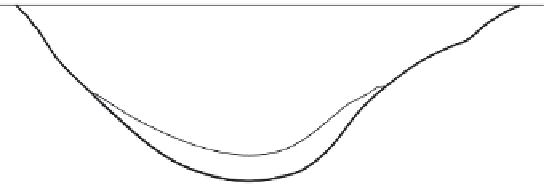Geoscience Reference
In-Depth Information
The TSI varies from 0 to 100. A TSI value of 100
relates to a Chl value of 1000
classification scheme for lake sediments (described
later in Fig. 4.3). Lakes also can be classified
according to their thermal properties, where the
lake water is separated into surface water (epi-
limnetic water) and deep water (hypolimnetic
water) by a thermocline (temperature stratifica-
tion), i.e. warmer, lighter waters are found on top
of colder, denser waters. Temperature stratifica-
tions occur in dimictic lakes (i.e. lakes that mix
twice a year, generally during spring and autumn).
Lakes also can be monomictic (such lakes circu-
late once a year) or polymictic (which mix many
times per year; see Wetzel 2001).
gL
−1
(the limit for
hypertrophic lakes). A TSI value of 75 relates
to a Chl value of 100
μ
gL
−1
, the limit between
eutrophic and hypertrophic lakes, etc. At Chl
values
μ
0.1, then the TSI should be set to 0.
In a similar manner to trophic status, lake humic
status can be determined using lake colour values
as a criterion for humic state. There are several
reasons to base the humic state index on colour.
Coloured substances such as humic and fulvic
acids reduce light transmission through water,
affect bioavailability and ecological effects of
nutrients and contaminants, affect plankton meta-
bolism and may inhibit secondary production
(Wetzel 2001). The colour value is generally deter-
mined by the comparative method using coloured
discs and expressed in mg Pt L
−1
(Håkanson et al.
1990). In this way, a Humic State Index (HSI)
may be defined on a scale from HSI
<
4.1.2 Controls on lake form
The size and form of lakes regulate many gen-
eral transport processes, such as sedimentation,
resuspension, diffusion, mixing, burial and
outflow (Fig. 4.2), which in turn regulate many
abiotic state variables, such as concentrations of
phosphorus, suspended particulate matter, pH
and many water chemical variables, colour and
water clarity. These in turn regulate primary
production, which in turn regulates secondary
production, for example of zooplankton and
fish (see Håkanson 2004). The morphometry of
a lake depends on the nature of the surrounding
land area, drainage basin characteristics and the
origin of the lake (see Table 4.2).
From the bathymetric map of a lake, one
can define a set of morphometric parameters
=
100, hyper-
humic, to HSI
=
0, ultraoligohumic, where: HSI
=
(100/3)log(colour
−
3). For example, for HSI
=
100 and colour
=
300 (mg Pt L
−1
) gives HSI
=
82,
3 (mg Pt L
−1
), then
HSI should be set to 0; but colour values
etc. (Note that if colour
<
<
3 and
1000 mg Pt L
−1
are very rare.)
The lake classification scheme in Fig. 4.1 uses
categories of primary production (autotrophy)
on the
x
axis and categories of catchment influ-
ence from soil, bedrock, vegetation and land-use
activities (allotrophy) on the
y
axis. This system
to classify lakes has much in common with the
>
Point source emissions
Precipitation
O
utflow
Inflow
Resuspension
Surface water
= epilimnion
ET-sediments
Primary production
Mixing
Wave base
Sedimentation
Deep water
= hypolimnion
Diffusion
Bioturbation
Active A-sediments
Biopassive A-sediments (geosphere)
Compaction
Burial
Fig. 4.2
Illustration of general and fundamental transport processes to, within and from lakes. The major sources of suspended
particulate matter are the inflow from tributaries, primary production in lakes, point-source emissions and direct deposition of particles
on the lake surface. The internal processes (sedimentation, resuspension, mixing, mineralization, biouptake and burial) redistribute the
suspended particles and regulate the retention and outflow of particles from the lake. See section 4.2.2.2 for an explanation of A- and
ET-sediments.







































